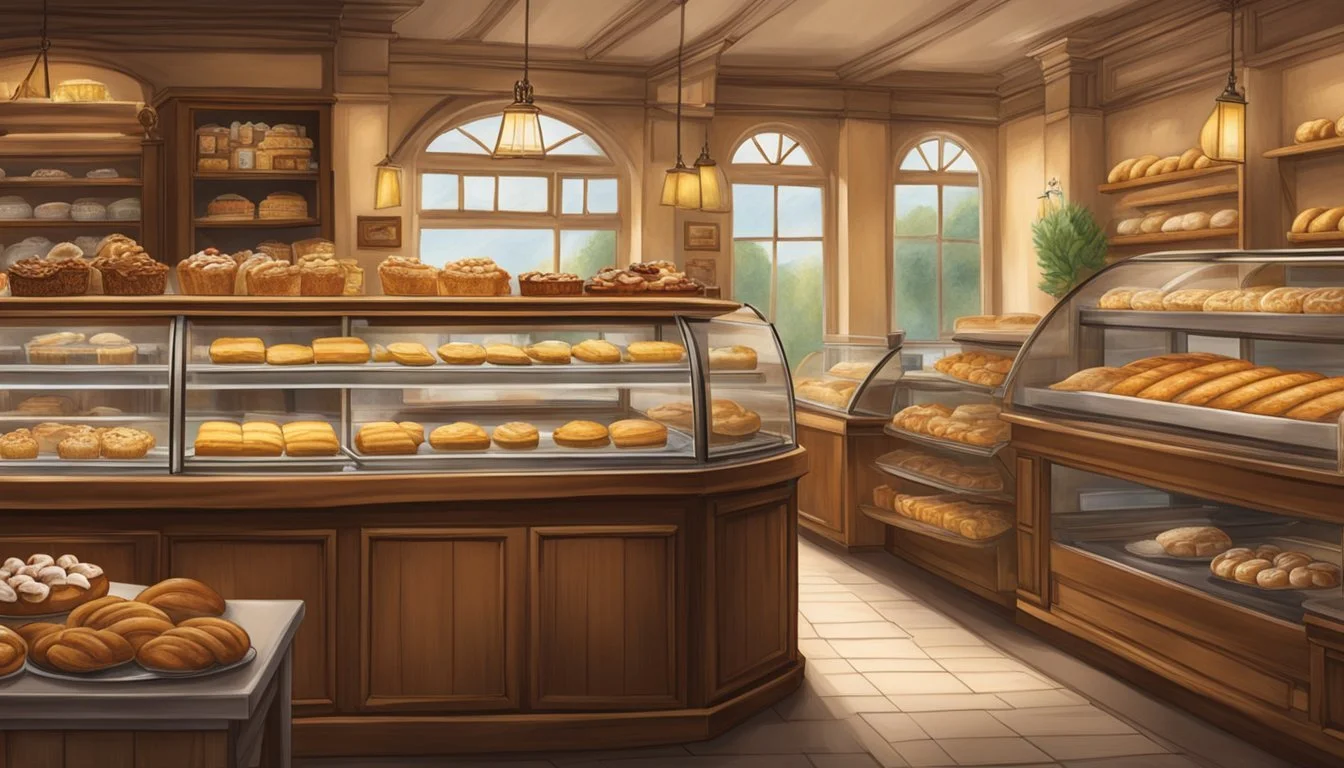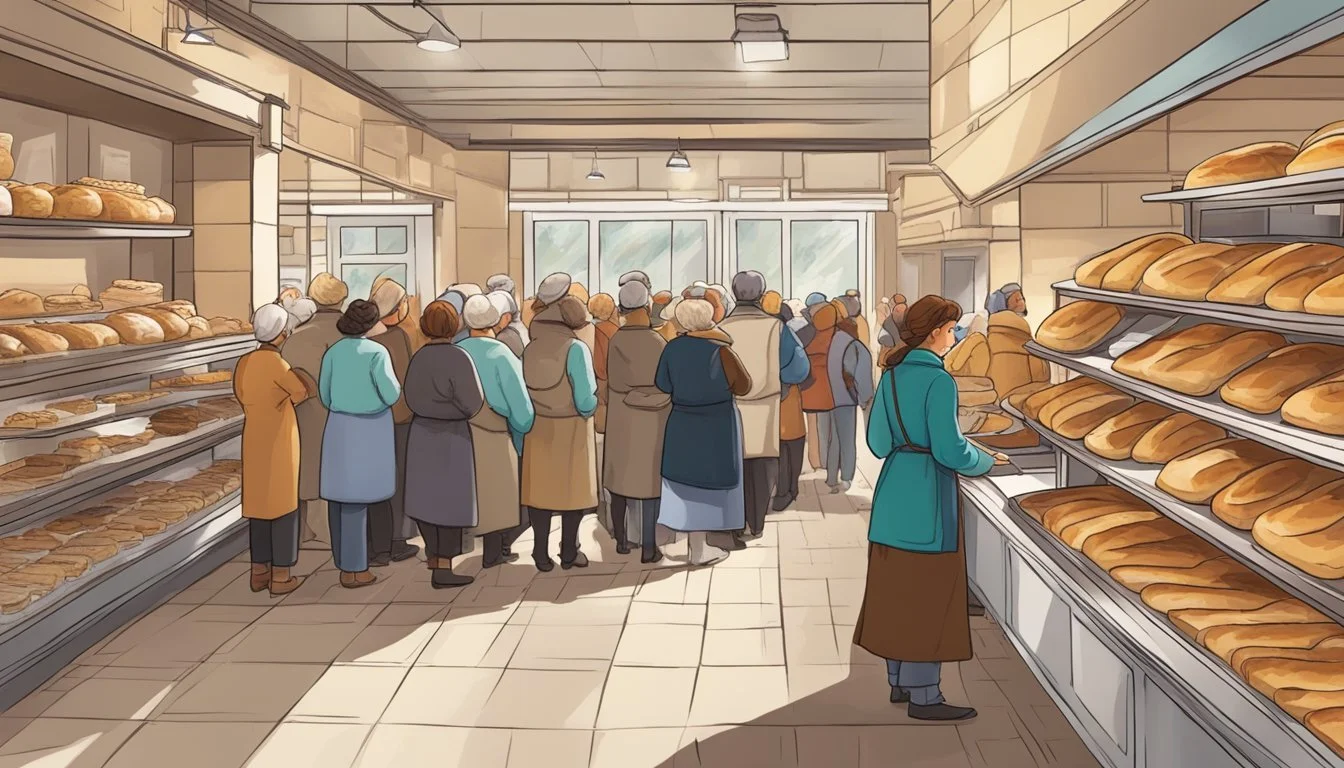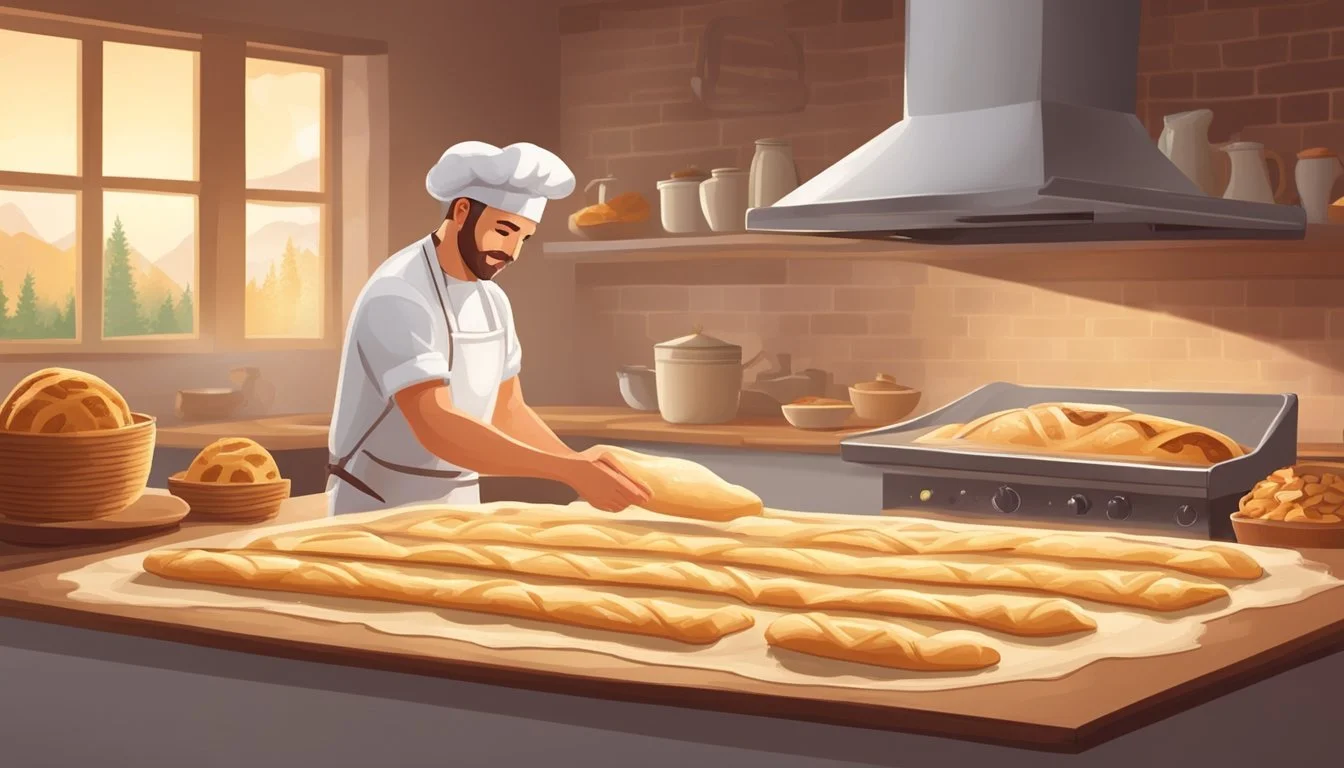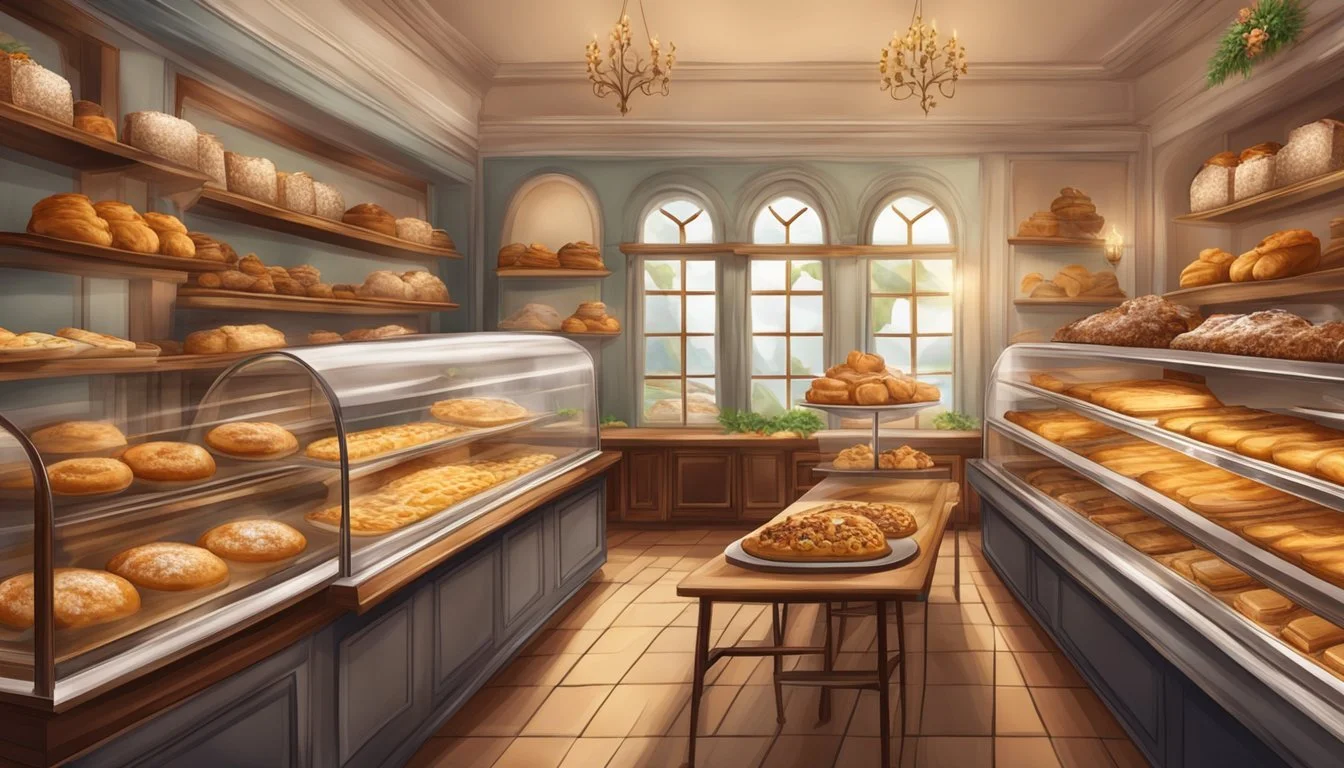German Texan Bakeries
Celebrating Culinary Heritage from Strudel to Stollen
In the heart of Texas, where cowboy culture meets European heritage, German Texan bakeries stand as a testament to the enduring legacy of German immigrants who settled in the Lone Star State during the 19th century. These bakeries are a haven for pastry enthusiasts, offering a taste of authentic German craftsmanship through every bite of strudel and stollen. Their baked goods hold the stories of generations, reflecting a cultural blend that is distinctly Texan yet deeply rooted in German traditions.
One notable establishment, Naegelin's Bakery in New Braunfels, has the honor of being the oldest bakery in Texas, serving the community since 1868. Their commitment to traditional techniques and recipes offers a genuine experience reminiscent of German baking. Likewise, Eilenberger's Bakery, which dates back to 1898, stands out as an enduring piece of Texan history, showcasing the state's rich tapestry of cultural influences through its confections.
From flaky strudel filled with tart apples to the dense, fruit-laden loaves of stollen at Christmas time, these bakeries not only satisfy the sweet tooth but also nourish the soul. Their products represent the fusion of German and Texan identities, inviting locals and visitors alike to savor a slice of history.
Origins of German Texan Bakeries
The German influence on Texan bakeries can be traced back to the mid-19th century when a significant influx of German immigrants settled in Texas, bringing their rich traditions of baking and pastry making to their new homeland.
History of German Immigration to Texas
German immigration to Texas began in earnest in the 1830s. By the mid-1800s, towns such as New Braunfels and Fredericksburg were established by these immigrant communities. They didn’t just bring their families and hopes for a better life; they brought with them a rich culinary tradition that has endured in Texas to this day.
Settlements:
New Braunfels: Founded by German settlers in 1845.
Austin: Became a hub for German culture in Texas.
Early Bakeries:
One notable example is Naegelin's Bakery in New Braunfels, which started in 1868 and is known as the oldest bakery in Texas.
Cultural Heritage
The German settlers' cultural heritage is particularly evident in their contributions to the local culinary landscape. Bakeries were one of the many ways they preserved their culture.
Bakery Offerings:
Traditional German pastries such as strudel and stollen became local favorites.
German Techniques:
Mastery in pastry making was prominent among German settlers, influencing Texan baking practices.
Culinary Tapestry:
Over time, Texan bakeries have infused local ingredients with German techniques, creating a unique culinary tapestry that reflects the state's diverse food heritage.
Essential Ingredients in German Baking
The richness of German baking starts with its foundation in high-quality ingredients. From robustly flavored breads to delicate pastries, the selection of flour, incorporation of nuts and fruits, and use of specific flavor enhancers is key to achieving authentic results.
Flour, Yeast, and Dough Base
Flour: The base for quintessential German baked goods, with types varying from wheat to rye.
Yeast: Active dry yeast is commonly used to leaven traditional breads such as stollen and bread rolls.
Dough Base Components:
Water or milk: Vital for hydrating the flour.
Sugar: Provides sweetness and color to pastries.
Salt: Balances flavors and regulates yeast.
Eggs: Richness and structure, particularly in cakes.
Butter: Adds flavor, tenderness, and a flaky texture in pastries.
Nuts, Dried Fruits, and Spices
Nuts: Almonds and hazelnuts are often ground or slivered, infusing baked items with a rich, nutty essence.
Dried Fruits (What wine goes well with dried fruits?): Raisins, sultanas, and candied fruits lend sweetness and texture.
Spices:
Cinnamon: A warm spice used in cookies and strudels.
Cardamom and vanilla: Often found in fine pastries and festive breads.
Citrus Peels: Lemon zest and orange peel add a bright, aromatic note.
Flavor Enhancers and Additions
Leavening Agents: Besides yeast, some recipes may employ baking powder or baking soda.
Fats: A variety of fats, like butter or lard, are chosen for textural effects.
Additional Flavorings:
Sugar varieties: Brown and confectioner's sugar tailor sweetness and texture.
Milk: Full-fat milk enhances richness and taste.
Eggs: Besides structure, eggs also contribute to the color and flavor profile.
Signature German Texan Baked Goods
In Texas, the fusion of German heritage with local traditions has given rise to a unique ensemble of baked goods. These comforting treats, ranging from stollen to strudel, are an integral part of the state's culinary landscape.
Understanding Stollen
Stollen, also known as German Christmas bread, is a rich, fruity bread that has become synonymous with the holiday season. A traditional stollen is laden with dried fruits, nuts, and spices, with a characteristic streak of marzipan running through its center. Its history surrounds the Advent and Christmas celebrations, where the sweet bread signifies comfort and festivity.
The Art of Strudel
The skillful preparation of apple strudel (Apfelstrudel) demonstrates the artistry in German Texan bakeries. Authentic strudel dough is hand-stretched to near transparency, filled with a blend of tart apples, raisins, cinnamon, and sugar, then rolled and baked until it boasts a flaky, golden crust. This dessert, with its crispy exterior and soft interior, showcases the German influence on Texas' culinary scene.
A Variety of German Cookies
German Texan bakeries offer an array of traditional cookies, which include but are not limited to cinnamon stars (Zimtsterne) and vanilla crescents (Vanillekipferl). Made from time-honored recipes, these cookies often feature bold flavors such as anise, almond, and ginger.
Common German Cookie Varieties:
Lebkuchen (gingerbread)
Spritzgebäck (spritz cookies)
Pfeffernüsse (spice cookies)
Other Popular German Desserts
Beyond strudel and stollen, other pastries and desserts enjoy popularity within these specialized bakeries. Panettone, while Italian in origin, has been embraced with a German twist—sometimes incorporating candied citrus and raisins into the bready cake. Other specialties may include various fruit tarts and layered cakes, often adorned with whipped cream, nuts, and fruits.
The Baking Process and Techniques
In German Texan bakeries, the art of making traditional pastries such as strudel and stollen hinges on meticulously following time-tested recipes and employing precise baking techniques.
Preparing Traditional Dough
They begin by selecting quality ingredients to prepare the dough, which is the foundation of any pastry. Strudel dough, for instance, consists of simple materials like flour, water, oil, and sometimes a touch of vinegar to maintain tenderness. The dough is then rested and rolled out to a paper-thin consistency. In contrast, stollen dough is richer, made with ingredients like flour, yeast, melted butter, eggs, and milk, sometimes incorporating soaked fruits and nuts, aligning with the traditional recipes that have been passed down for generations.
Mastering Baking Temperatures and Times
German Texan bakeries are adept at controlling their ovens to achieve the perfect bake. Strudel dough requires a higher temperature to turn the thin dough crisp and golden in a short amount of time, while stollen is baked at a lower temperature to ensure the dense dough cooks through without burning. Timing is crucial; a strudel may only need a few minutes, whereas stollen can require up to an hour, depending on the size of the loaf and the specific recipe.
Decoration and Presentation
Post-baking, attention to detail in decoration and presentation is key. For instance, stollen is traditionally brushed with melted butter and liberally dusted with powdered sugar, serving both an aesthetic function and adding to the richness of flavor. The baked goods are usually displayed on a baking sheet or decorative surface to enhance their artisanal appeal. Presentation techniques reflect the festive and hearty nature of the pastries, inviting patrons to not only taste but also appreciate the craftsmanship of these German-Texan specialties.
Celebrating Festivities and Holidays
In the vibrant German-Texan communities, bakeries play a pivotal role in commemorating traditional festivities, particularly during the Christmas and Easter seasons. They honor these times with a variety of special baked goods steeped in heritage, offering a taste of cultural history through their culinary creations.
Christmas and Easter Delicacies
During Christmas, Dresdner Christstollen, a rich and fruit-laden bread, takes center stage. Originating from Dresden, Germany, this bread has a centuries-long association with the holiday season. Traditional ingredients include candied citrus peel, marzipan (featured in Marzipanstollen), and a mix of warm spices. Its significance is so profound that in 1434, it was sold at the Dresden Christmas market, highlighting the bread’s longstanding festive connection.
In contrast, Easter delicacies embody the joy of spring and the end of Lent. The offerings combine sweet and light pastries representing the conclusion of austerity from Lent. The Catholic Church, under Pope Innocent VII, had once banned butter during Lent, but the rule was relaxed, allowing richer ingredients in holiday baking, adding a layer of tradition to the already meaningful festivities.
German Festivals in Texas
October in Texas is greeted with an array of German festivals where locals and visitors alike can revel in the cultural fusion of German and Texan traditions. These festivals often feature a variety of authentic German baked goods. Visitors during these occasions can expect to enjoy strudel filled with seasonal fruits and spiced pastries, echoing the harvest-time celebrations of Germany. The festive atmosphere, bolstered by traditional foods, pays homage to German settlers' historical influence on local customs and gastronomy.
Innovation and Tradition
German Texan bakeries elegantly balance the preservation of their time-honored baking traditions while embracing the practical innovations of contemporary bakery craftsmanship. This interplay ensures the survival of classic recipes and techniques, even as they adapt to changing consumer preferences and market dynamics.
From Home-Baked to Store-Bought
Traditionally, German Texan households would create their own baked goods, often handed down through generations. Naegelin's Bakery in New Braunfels, Texas, represents the evolution from homemade to store-bought, as it has been delivering authentic German baked goods since 1868. Local bakeries like Naegelin’s have become institutions, offering a wide array of homemade quality pastries in a store-bought format for the wider community.
Modern Interpretations of Classic Recipes
Bakers are not only custodians of tradition but also innovators. They experiment with classic recipes, offering modern interpretations to appeal to a diverse clientele. Whether it's through incorporating non-traditional ingredients or utilizing advanced baking techniques, these bakeries give a fresh twist to beloved staples such as strudel and stollen while maintaining the core essence which defines these specialties.
The Role of Bakeries in Community
The role of German Texan bakeries extends beyond mere food production—they are central to community life. Dresden Stollen Bakers highlight this role, connecting with their customers by baking Dresden Stollen annually, a symbolic tradition that reinforces communal bonds during the holiday season. These bakeries often become a gathering place, reinforcing their importance as a social hub in the community.
Conclusion
The cultural tapestry of Texas is richly woven with German threads, a heritage evident in its enduring culinary traditions. German bakeries are a testament to this legacy, serving as communal landmarks where the fusion of Texan and German sensibilities is celebrated. In these establishments, the air is heavy with the scent of freshly-baked goods, from the flaky layers of strudel to the dense, fruit-filled stollen.
Naegelin's Bakery stands as a prominent beacon of this tradition in New Braunfels, having delighted patrons since 1868. It epitomizes the committed preservation of German baking techniques, passed down through generations. Their products, a harmonious blend of old-world recipes and Texan tastes, have become synonymous with quality and authenticity.
Within these welcoming spaces, knowledgeable bakers share their craft, while fostering a sense of community. They serve not just as purveyors of baked goods, but as custodians of culture, ensuring that the German-Texan narrative continues through every strudel twisted and each stollen sliced.
Operating Hours: Reflective of consumer habits, these bakeries accommodate early risers and weekend gatherings alike.
Product Array: While adhering to traditions, they often adapt their offerings to the seasons, introducing items like marzipan and cranberry walnut stollen for holidays.
Thus, German bakeries in Texas stand as living museums, showcasing the survival and evolution of culinary heritage. Here, anyone can step through the door and into a story that began over a century ago, a story still being baked to perfection daily.
Appendix
This section provides additional resources for those interested in exploring German Texan bakery offerings in more depth, including recipes and a directory of establishments.
Detailed Recipes and Guides
With a focus on authenticity, recipes such as Dresdner Stollen or traditional apple strudel can be found with precise measurements and step-by-step instructions. It's notable that some ingredients should be at room temperature for optimal results. Guides often emphasize the importance of allowing the dough to rest in a warm place to achieve the texture that's synonymous with quality German pastries.
List of German Texan Bakeries
Below is a directory of bakeries where one can experience original German baked goods in Texas:
Naegelin's Bakery, New Braunfels, TX
Opening Hours:
Weekdays: 6:30 a.m. - 5:30 p.m.
Saturday: 6:30 a.m. - 5:00 p.m.
Sunday: 9:00 a.m. - 4:00 p.m.Dresden Stollen Bakers
Note: Stollen is baked and sold once a year. Orders for 2024 can be placed starting a designated date.Dagmar's Bakery
Specializes in a variety of Stollen including marzipan and cranberry walnut, alongside other German-style sweets.







